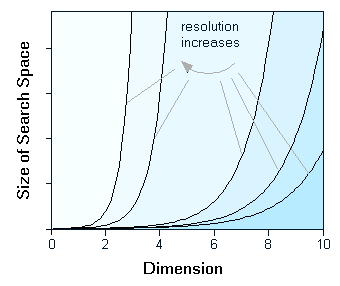 You are working with the text-only light edition of "H.Lohninger: Teach/Me Data Analysis, Springer-Verlag, Berlin-New York-Tokyo, 1999. ISBN 3-540-14743-8". Click here for further information.
You are working with the text-only light edition of "H.Lohninger: Teach/Me Data Analysis, Springer-Verlag, Berlin-New York-Tokyo, 1999. ISBN 3-540-14743-8". Click here for further information.
 You are working with the text-only light edition of "H.Lohninger: Teach/Me Data Analysis, Springer-Verlag, Berlin-New York-Tokyo, 1999. ISBN 3-540-14743-8". Click here for further information. You are working with the text-only light edition of "H.Lohninger: Teach/Me Data Analysis, Springer-Verlag, Berlin-New York-Tokyo, 1999. ISBN 3-540-14743-8". Click here for further information.
|
Table of Contents  Multivariate Data Multivariate Data  Optimization Optimization  Phase Space Phase Space |
|
| See also: optimization |   |
Optimization can be understood as finding the highest (lowest) value
of the response function calculated for a set of n parameters.
| Phase Space | The phase space of a system is the set of n variables which is sufficient to describe a system. The phase space is never unique to a given problem, since any given phase space can be transformed to another one. |
Example:
A useful phase space to describe the movement of a pendulum would consist of its position and the current acceleration.
What is important for practical optimization strategies is to keep the
"size" of this phase space (or search space) in mind: the finer the resolution
of the description of a system, the more points are necessary to cover
the whole range of possible states of the system. The size of the search
space increases dramatically with higher resolution and with an increasing
number of variables:

Last Update: 2005-Jul-16